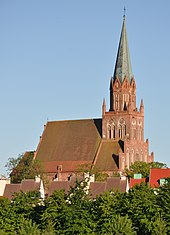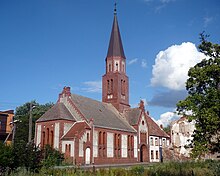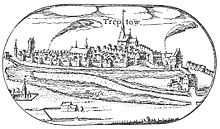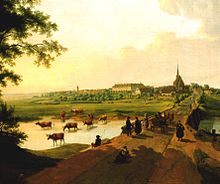Trzebiatów
| Trzebiatów | ||
|---|---|---|
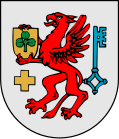
|
|
|
| Basic data | ||
| State : | Poland | |
| Voivodeship : | West Pomerania | |
| Powiat : | Gryfice | |
| Area : | 10.00 km² | |
| Geographic location : | 54 ° 4 ′ N , 15 ° 16 ′ E | |
| Height : | 8 m npm | |
| Residents : | 9986 (Jun. 30, 2019) |
|
| Postal code : | 72-320 | |
| Telephone code : | (+48) 91 | |
| License plate : | ZGY | |
| Economy and Transport | ||
| Street : | Ext. 102 : Międzyzdroje ↔ Kołobrzeg | |
| Ext. 103 : Kamień Pomorski → Trzebiatów | ||
| Ext. 109 : Mrzeżyno ↔ Płoty | ||
| Rail route : | PKP - route 402: Koszalin – Goleniów | |
| Next international airport : | Szczecin-Goleniów | |
| Gmina | ||
| Gminatype: | Urban and rural municipality | |
| Gmina structure: | 26 villages | |
| 21 school authorities | ||
| Surface: | 225.00 km² | |
| Residents: | 16,163 (Jun. 30, 2019) |
|
| Population density : | 72 inhabitants / km² | |
| Community number ( GUS ): | 3205083 | |
| Administration (as of 2010) | ||
| Mayor : | Zdzislaw Matusewicz | |
| Address: | Rynek 1 72-320 Trzebiatów |
|
| Website : | www.trzebiatow.pl | |
Trzebiatów [ tʃɛˈbjatuf ] (German Treptow an der Rega ) is a town with a town and country municipality in the Polish West Pomeranian Voivodeship in the Powiat Gryficki ( Greifenberg i. Pom. district ).
Geographical location
The city is located in Western Pomerania , about 30 kilometers southwest of Kolberg and 110 kilometers northeast of Szczecin . It is enclosed on three sides by the Rega River , which flows eleven kilometers into the Baltic Sea. The place covers an area of about nine square kilometers and is 8.5 meters above sea level.
history
The city of Treptow an der Rega had a special meaning for the religious life in Pomerania . On the one hand, it was the place of activity of Johannes Bugenhagen , who was significantly involved in the introduction of the Evangelical Lutheran faith in Pomerania in the 16th century with the "Bugenhagen Church Order" he wrote . On the other hand, the city was the place where the Landtag of Treptow in 1534 at the instigation of the Pomeranian dukes Barnim IX. and Philip I decided to introduce Lutheran teaching ( Reformation ).
middle Ages
At the end of the 12th century there was a village called Bollenburg, inhabited by Wends , on a Rega island below a castle wall. To the west of this square, German immigrants settled in the first half of the 13th century, whom the Pomeranian Duke Barnim I had recruited to settle his country. It was relatively late settlement received under the name of Treptow Barnim I, composed of his son Bogislaw IV. In 1277 the Lubeck city rights . At this point in time, Barnim's first town was founded 42 years ago, in Prenzlau .
In 1180, the Belbuck Premonstratensian Abbey was built north of the city - in what is now the Białoboki district - which also contributed to the settlement of the area. However, the monastery fell into disrepair as early as the 16th century. In 1224, Anastasia, the widow of Duke Bogislaw I , gave Treptow Castle and a number of associated villages to the Premonstratensians of Belbuck for the establishment of a daughter monastery; The Marienbusch Premonstratensian monastery that grew out of it, in which Anastasia spent the last years of her life and was buried, was initially built outside the city in Wischow and was only moved to the city of Treptow in 1286/87.
To strengthen its trading power, Treptow was granted the right of free shipping on Rega in 1287 and duty-free in the Pomeranian lands. This made it possible for the city to join the Hanseatic League and to establish trade relations on the Baltic coast from Lübeck to Riga . However, when the decline of the Hanseatic League began to emerge, Treptow officially declared his exit again in 1450. Instead of wendischen Burg Walles of Premonstratensian was nuns the Klostermarienberg Busch - in the previously Wyszkowo ( Wischow built, which in a 1750 - stand) classical palace was converted. The city fortifications were built around 1300 and the remains of the wall and the so-called Grützurm tower are still preserved today. In 1303 work began on the three-aisled St. Mary's Church, which was not completed until 1370. Located near the mouth of the river, Treptow was able to control shipping traffic on the Rega almost without restriction. Among other things, this resulted in violent disputes with Greifenberg to the south , which culminated in 1449 when Treptow tried to block the river. To promote its own shipping, Treptow built the port of Regamünde at the mouth of the river , but it was destroyed by a storm flood in 1456. The council school was founded at the end of the 15th century, and Bugenhagen was the principal from 1504 to 1521.
Early modern age
After the Pomeranian dukes Barnim IX. and Philip I met in Cammin on August 24, 1534 and, at the insistence of their councilors, had decided to negotiate a reorganization of the religious and political system with the estates at a joint state parliament, one was scheduled in Treptow in December of the same year. At this state parliament, with the participation of Bugenhagen, who was an advocate of Lutheran doctrine, a draft of a new church order in Low German was worked out, the main purpose of which was the establishment of a unified Protestant regional church in Pomerania under sovereign patronage. At this state parliament in mid-December, the two dukes announced their decision, which was significant for all of Pomerania, to accept the Lutheran teaching.
During the Thirty Years' War Treptow suffered from the looting of the imperial army. After the end of the war, the city came under the rule of Brandenburg in 1648 , was administratively assigned to the Greifenberg district and became a garrison town. In 1740 Treptow had 2,738 inhabitants. From 1750 to 1763, Prince Friedrich Eugen von Württemberg lived, with interruptions, as a Prussian officer in Treptow Castle. Five of his children were born in Treptow, including the future King Friedrich I of Württemberg. His daughter Sophie Dorothea also grew up in Treptow; she later became Empress of Russia as Maria Feodorovna. Later, in 1809, the Prussian King Friedrich Wilhelm III. Maria Feodorowna gave a picture of Treptow, initially had Karl Friedrich Schinkel make a few drawings, but then decided on a painting by Peter Ludwig Lütke (see picture on the right).
19th and 20th centuries

In the middle of the 19th century, the city began to expand with new housing developments, and with the connection to the Greifenberg – Kolberg railway line in 1882, industry in Treptow also began to expand. A silver ware factory was founded, and sugar and building materials factories were established. At that time Treptow had about 7,000 inhabitants. At the beginning of the 20th century, Treptow had two Protestant churches, a synagogue , a grammar school, an agricultural winter school and a district court.
In 1901 the Treptow NCO School was opened on Rega . Extensive barracks were built before each of the two world wars, and in the 1920s there was another expansion of the city with settlements on the outskirts. When in 1939 a German census determined the population of Treptow for the last time, 10,908 people lived there.
Until 1945 the town of Treptow a./Rega belonged to the district of Greifenberg i. Pom. in the administrative district of Köslin in the Prussian province of Pomerania of the German Empire .
When the West German cities were regularly bombed by the Royal Air Force and the US Air Forces during the Second World War (→ Luftkrieg # Bombing raids on Germany ), many bombed-out people and people seeking protection came to Treptow who had relatives here. As a result of the bombing raids, regular school lessons could no longer be carried out in the Ruhr area from 1943 ; Therefore, entire schools and their teaching staff were evacuated from there to Western Pomerania (→ Kinderlandverschickung ). First of all, a primary school from Bochum came to Treptow with teaching staff and relatives of the pupils, as long as they were not deployed in their hometowns. On August 7, 1943, the high school from Herne followed with around 75 percent of the students and relatives. Students who arrived without relatives were placed with foster parents. The school lessons for the evacuated students were carried out in the existing school buildings, but had to be postponed for the most part to the afternoon due to the severe overcrowding of the classrooms.
Since the beginning of 1945, uninterrupted treks of refugees came through the city, who had fled with horse-drawn carriage from the front line approaching via East Prussia . When the Red Army reached Treptow on March 4, 1945, the city was overcrowded with people. All the roads to the west were clogged, reception camps and refreshment points were no longer available, and it was only possible to escape on foot. When the Soviet troops moved into the city, it was spared from war. All houses were intact, the factories were intact, the mills and other facilities were set to be supplied until the next harvest, and the gas and electricity supplies were secured. Nevertheless, a period of suffering began for the remaining population. The destruction of large parts of the city of Treptow at the end of the Second World War only began after the fighting had ceased.
At the beginning of March 1945, the Sea Rescue Squadron 81 of the German Air Force tried to bring thousands of German children who had been evacuated to the Baltic Sea due to the bombing war to safety from the approaching Soviet troops. These also were flying boats of the type Dornier Do 24 used that brought the children from the former air base in Kamp west. On March 5, 1945, a Do 24 crashed into Lake Kamper (Resko Przymorskie) shortly after taking off. The crash probably happened as a result of enemy fire. Crew, carers and over 70 children were killed. The wreck lies in the lake with the remains of the victims to this day. Due to an initiative of local authorities and the Volksbund Deutsche Kriegsgräberfürsorge the dead are to be recovered.
After Western Pomerania was placed under Polish administration in the summer of 1945 after the end of the war , Poles and Ukrainians began to immigrate, many of them deported from areas east of the Curzon Line that had fallen to the Soviet Union . For Treptow, the Poles introduced the new place name Trzebiatów . By the summer of 1946, the majority of German citizens from Treptow and nearby villages were expelled .
Demographics
| year | Residents | Remarks |
|---|---|---|
| 1740 | 2,738 | |
| 1782 | 2,734 | including 24 Jews |
| 1794 | 3,487 | including 28 Jews |
| 1800 | approx. 3,500 | |
| 1812 | 3,672 | 45 Catholics and 35 Jews |
| 1816 | 3,887 | 42 Catholics and 51 Jews |
| 1831 | 4,968 | including 26 Catholics and 130 Jews |
| 1843 | 5,288 | including 16 Catholics and 161 Jews |
| 1852 | 5,760 | including 32 Catholics and 192 Jews |
| 1861 | 6,198 | including 35 Catholics and 181 Jews |
| 1867 | 6,957 | |
| 1875 | 6,724 | |
| 1880 | 7,052 | |
| 1890 | 6,258 | including 36 Catholics and 146 Jews |
| 1905 | 7,794 | 84 Catholics and 109 Jews |
| 1925 | 8,149 | 7,584 Protestants, 114 Catholics and 79 Jews |
| 1933 | 9,066 | |
| 1939 | 10.184 | thereof 9,722 Evangelicals, 212 Catholics, 32 other Christians and 41 Jews |
| 2013 | 10,202 |
Attractions
The historical city center with its medieval character is well worth seeing .
The center of the chessboard-shaped city complex is the square market square with the town hall built in 1701 in the Baroque style and surrounding town houses.
The Catholic Parish Church of the Motherhood of Mary (Kościół Macierzyństwa Najświętszej Marii Panny) was a Protestant parish church before 1945. The three-aisled hall church with its 90 meter high tower was built in the 14th and 15th centuries. Century and is an important building of the brick Gothic . The tower was given its present form in 1864 by the royal Prussian master builder Friedrich August Stüler .
Today's St. John's Church of the Evangelical Augsburg Church in Poland was built in the neo-Gothic style at the beginning of the 20th century for the Evangelical Lutheran Church in Prussia and was consecrated on September 17, 1905.
The classicist castle from the end of the 18th century goes back to the former castle of the griffins .
Fragments of the medieval city wall with the Grützurm (Baszta Prochowa) have been preserved.
traffic
The ferry to Świnoujście ( Swinoujscie ) with connections to Ystad , Malmö and Copenhagen is 80 km away. In the city, the provincial roads (meet droga wojewódzka .) No 102 ( Międzyzdroje ( Misdroy -) Kolobrzeg ( Kolberg )), 103 ( Kamien Pomorski ( Cammin ) - Trzebiatów) and 109 ( Mrzeżyno ( Deep ) - Płoty ( Plathe )).
The Goleniów ( Gollnow ) - Koszalin ( Köslin ) railway runs through the town, which until 1945 was also connected to the railway from Wietstock (Wysoka Kamieńska) via Cammin (Kamień Pomorski) . The Greifenberger Kleinbahn has ended here since 1913 , and since 2000 it has only run as far as Pogorzelica ( Fischerkaten ) due to a Rega crossing that is no longer passable .
Town twinning
- Grevesmühlen , Germany
- Großräschen , Germany
- Wandlitz , Germany
- Istebna , Poland
- Sjöbo , Sweden
Personalities
sons and daughters of the town
- Henning Parcham (1552–1602), German businessman and councilor from Lübeck, founder
- Johann Bütow (around 1565 - after 1626), German theologian and poet
- Jürgen Pavels (1568–1645), German merchant and councilor from Lübeck
- Valentin von Winther (1578–1623), German annalist, councilor at the court of Duke Philip II of Pomerania
- Friedrich I. Wilhelm Karl von Württemberg (1754-1816), later King Friedrich I. von Württemberg
- Ludwig von Württemberg (1756–1817), Prince of Württemberg, general of the cavalry
- Ferdinand Friedrich August von Württemberg (1763–1834), German officer in Austrian service
- Friederike von Württemberg (1765–1785), Princess of Württemberg, wife of Peter Friedrich Ludwig von Holstein-Gottorp
- Elisabeth von Württemberg (1767–1790), Princess of Württemberg, wife of the later Emperor Franz II.
- Joachim Gottfried Wilhelm Scheerer (1772–1826), German writer
- Ludwig von Wurmb (1788–1855), Prussian major general and commander of the 2nd Cavalry Brigade
- Heinrich von Reitzenstein (1796–1865), Prussian infantry general and vice governor of the Mainz fortress
- Gustav Adolph Linke (1798–1867), Prussian construction clerk and university professor
- Ludwig Friedrich Kämtz (1801–1867), German physicist and meteorologist
- Ludwig Granier (1808–1857), German judge and politician
- Johann Gustav Droysen (1808–1884), German historian, founder of the Prussian-Little German historiography
- Friedrich Carl Wilhelm Bütow (1813–?), German organ builder
- Ferdinand von Arnim (1814–1866), German architect and watercolor painter
- Peter Friedrich Arndt (1817–1866), German mathematician, private lecturer at the University of Berlin
- August Zillmer (1831–1893), German actuary, namesake of Zillmerung
- Oskar von Lettow-Vorbeck (1839–1904), Prussian major general and military writer
- Hans Euen (1857–1912), German landowner and member of the German Reichstag
- Günther von Krosigk (1860–1938), German admiral
- Justus Baltzer (1863 – after 1935), German pedagogue, director of the secondary girls' school and Lyceum of the Francke Foundations
- Siegfried Sudhaus (1863–1914), German classical philologist and papyrologist
- Paul Kalmus (1864–1940), German Protestant theologian, general superintendent of the Ostsprengels of the ecclesiastical province of Pomerania
- Ulrich Hildebrandt (1870–1940), German church musician
- Kurt Matull (1872–?), German writer, journalist, director and screenwriter
- August Horneffer (1875–1955), German philologist and active Freemason
- Hans Lorenz von Versen (1881–1931), Prussian district administrator in the Löbau and Rosenberg districts
- Erich Keup (1885–1973), German economist
- Horst Bien (1920–1993), German literary scholar and translator, professor in Greifswald
- Hans Hermann Rosenhagen (1901–?), German politician (NSDAP)
- Herbert Daniel (1926–2019), German experimental physicist
- Klaus Stephan (1927–2002), German television journalist and presenter
- Rolf Vollmann (* 1934), German author and literary critic
- Michael Behnen (* 1938), German historian
- Gerd Reinke (* 1941), German double bass player and teacher
- Heinrich Matzat (* 1945), German mathematician
- Konstanty Oświęcimski (* 1964), Polish politician
Personalities who have worked locally
- Andreas Knöpken (around 1468–1539), reformer, after studying Bugenhagen's assistant and in 1521 his successor
- Elisabeth Cruciger (around 1500–1535), a nun in the Treptow Monastery, fled to Bugenhagen
- Johannes Bugenhagen (1485–1558), reformer, was rector of the Treptow city school from 1505 to 1521
- Johannes Aepinus (1499–1553), reformer, pupil of Bugenhagen in Treptow
- Daniel Gottlob Thebesius (1707–1757), district physician, mayor of Treptow
- Erich Haupt (1841-1910), high school teacher in Treptow
- Ernst Janke (1873–1943), mayor
Gmina Trzebiatów
The urban and rural community of Trzebiatów has around 16,000 inhabitants on an area of 225 km². In addition to the main town of the same name, it is divided into 21 municipal parts:
- Bieczyno (Hagenow)
- Chomętowo (Gumtow)
- Gąbin (gummin)
- Gołańcz Pomorska (Glansee)
- Gołańcz Pomorska II
- Gorzysław (Arnsberg)
- Gosław (Gützlaffshagen)
- Jaromin
- Kłodkowo (Klätkow)
- Lewice (Lewetzow)
- Mirosławice (Gumminshof)
- Mrzeżyno (Deep)
- Nowielice (Neuhof)
- Roby (robe)
- Rogozina (Mittelhagen)
- Sadlno (Zedlin)
- Siemidarżno (cinnamon)
- Trzebusz ( shoots )
- Trzebusz Osiedle
- Wlewo (Wefelow)
- Włodarka (Voigtshagen)
The Kępa (Kamp) and Wyszkowo (Wischower Church) deserted areas and the village of Rogowo on Lake Kamper are also located in the municipality .
literature
- Gustav Kratz : The cities of the province of Pomerania - outline of their history, mostly according to documents . Berlin 1865, pp. 510-519 ( full text ).
- Our Pommerland , vol. 13, no . 5-6: Treptow ad Rega .
- Heinrich Berghaus : Land book of the Duchy of Pomerania and the Principality of Rügen . Part II, Volume 6: Kreise Kamin and Greifenberg , Anklam 1870, pp. 730–954 ( full text ).
- Johann Ernst Fabri : Geography for all classes . Part I, Volume 4, Leipzig 1793, pp. 493-496 ( full text ).
- Hans Schulz (Ed.): 675 years of the city of Treptow (Rega) . Dankert, Hamburg 1952.
- 700 years Treptow ad Rega - May 6, 1277 - 1977 (compiled by Wilhelm Kressin). Rautenberg-Druck, Glückstadt 1977.
- Hans Schulz-Vanselow: City of Treptow on the Rega - land and people . Leopold Verlagsdruckereigesellschaft mbH, Bonn 1979.
- Königliches Bugenhagen-Gymnasium: Annual report of the Königliches Bugenhagen-Gymnasium in Treptow a. Rega , 1894-1915, online
- Ulrich, Dr .: Amt Treptow, formerly Belbuck Abbey in the Greifenberg district during the 17th and 18th centuries .
- Albert Heintze : History of the city of Treptow on the Rega. Vol. I: From the founding of the city to the Reformation . Ed. by J. Girgensohn, Treptow 1906. (Vol. II no longer published)
Web links
- City of Treptow a./Rega (Rolf Jehke, 2015)
- The town of Treptow a./Rega in the former Greifenberg district in Pomerania (Gunthard Stübs and Pommersche Forschungsgemeinschaft, 2011)
- City website (Polish)
Individual evidence
- ↑ a b population. Size and Structure by Territorial Division. As of June 30, 2019. Główny Urząd Statystyczny (GUS) (PDF files; 0.99 MiB), accessed December 24, 2019 .
- ↑ See Hermann Hoogeweg : The founders and monasteries of the province of Pomerania. Volume 2, Stettin 1924, pp. 458-461.
- ↑ Martin Wehrmann : The Landtag to Treptow an der Rega 1534 . In: Blätter für Kirchengeschichte Pomerania, Volume 12, 1934, pp. 31–65.
- ↑ a b c d Heinrich Berghaus : Land book of the Duchy of Pomerania and the Principality of Rügen . Part II, Volume 6: Kreise Kamin and Greifenberg , Anklam 1870, p. 734.
- ↑ Hans Schulz-Vanselow: Schinkel and Lütke in Treptow on the Rega. In: Pomerania. Journal of Culture and History. Issue 4/1990, ISSN 0032-4167 . Reprinted in: Die Pommersche Zeitung. Episode 10/2011, pp. 5, 16.
- ↑ a b Meyer's Large Conversation Lexicon . &. Edition, Volume 19, Leipzig and Vienna 1909, pp. 693–694.
- ↑ a b Kressin (1977), pp. 44-45.
- ↑ Die Welt: The Lake of the Dead Children.
- ↑ a b c d e f g h Gustav Kratz : The cities of the province of Pomerania - outline of their history, mostly according to documents . Berlin 1865, pp. 510-519 ( full text ), here p. 517.
- ↑ a b c d e Michael Rademacher: German administrative history from the unification of the empire in 1871 to the reunification in 1990. Grabberg.html # ew39grbgtreptow. (Online material for the dissertation, Osnabrück 2006).
- ↑ The city Treptow a./Rega in the former Greifenberg county in Pomerania (Gunthard Stübs and Pomeranian Research Foundation, 2011)



